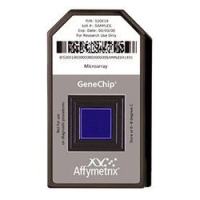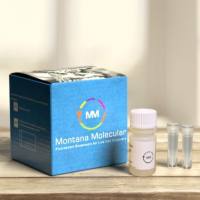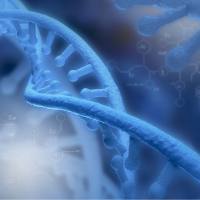Targeted Sequencing Using Affymetrix CustomSeq Arrays
互联网
- Abstract
- Table of Contents
- Materials
- Figures
- Literature Cited
Abstract
This unit provides a basic protocol for oligo hybridization?based sequencing technology and resulting data analysis specific to the Affymetrix GeneChip CustomSeq Resequencing Array platform. All steps and critical aspects related to array design, experimental protocols, data management, and base?calling algorithms are addressed. This unit is particularly appropriate for sequencing targeted regions of the genome of up to 300 kilobases. The basic technology is most suitable for detecting substitution mutations, unless targeted indel probes are added. Curr. Protoc. Hum. Genet. 69:7.18.1?7.18.17 © 2011 by John Wiley & Sons, Inc.
Keywords: resequencing microarrays; CustomSeq; base?calling; sequence?specific; hybridization; mutation detection
Table of Contents
- Introduction
- Basic Protocol 1: Critical Aspects of Design, Execution, and Analysis of Affymetrix GeneChip CustomSeq Arrays
- Commentary
- Literature Cited
- Figures
- Tables
Materials
Basic Protocol 1: Critical Aspects of Design, Execution, and Analysis of Affymetrix GeneChip CustomSeq Arrays
Materials
|
Figures
-
Figure 7.18.1 Customized pipeline for data analysis. Abbreviations: BRLMM, genotyping software; CEL, cell intensity; DAT, data; GCOS, GeneChip operating software; GSEQ, GeneChip sequence analysis software; SNP, single‐nucleotide polymorphism. View Image -
Figure 7.18.2 DAT file shows an image of the scanned probe array. View Image -
Figure 7.18.3 Minor allele tiling probes include the variant and ±12 base pairs. A total of 49 base pairs is submitted to Affymetrix to create probes to sequence the affected region. View Image -
Figure 7.18.4 Offset tiling uses additional probes with interrogating positions offset to the 5′ or 3′ end of the probe to increase sensitivity and specificity. View Image -
Figure 7.18.5 Probe design strategy for genotyping. Resequencing probes are placed with a minor/mutant allele at different offsets (9 offsets) to interrogate one genotype (A) and sequence 9 contiguous bases at the same time (GTCCTACGG). View Image -
Figure 7.18.6 Sample of a summary report generated from our data analysis pipeline. All positions requiring a confirmatory sequencing method are listed in the Follow Up Positions section. For each position, the gene, exon, and wild‐type base are indicated. In the Call column, triplicate calls are shown, as well as minor allele tiling calls due to the presence of a nearby single‐nucleotide polymorphism (SNP). When tiled, genotyping calls are noted next to the relevant base. The results of confirmatory Sanger sequencing are noted in the final column (Seq Confirmation). Non‐wild‐type base calls that are not followed up are listed in the subsequent sections including benign SNPs, as well as calls filtered out due to identification during test validation as a site of a common false positive or no‐call. View Image
Videos
Literature Cited
| Cutler, D.J., Zwick, M.E., Carrasquillo, M.M., Yohn, C.T., Tobin, K.P., Kashuk, C., Mathews, D.J., Shah, N.A., Eichler, E.E., Warrington, J.A., and Chakravarti, A. 2001. High‐throughput variation detection and genotyping using microarrays. Genome Res. 11:1913‐1925. | |
| Zimmerman, R.S., Cox, S., Lakdawala, N.K., Cirino, A., Mancini‐DiNardo, D., Clark, E., Leon, A., Duffy, E., White, E., Baxter, S., Alaamery, M., Farwell, L., Weiss, S., Seidman, C.E., Seidman, J.G., Ho, C.Y., Rehm, H.L., and Funke, B.H. 2010. A novel custom resequencing array for dilated cardiomyopathy. Genet. Med. 12:268‐278. | |
| Internet Resources | |
| http://www.affymetrix.com/support/technical/byproduct.affx?product=cseq | |
| CustomSeq array resources provided by Affymetrix. | |
| http://www.affymetrix.com/support/technical/datasheets/customseq_datasheet.pdf | |
| GeneChip CustomSeq Resequencing Array Program Data Sheet provided by Affymetrix. | |
| https://www.affymetrix.com/support/downloads/manuals/gseq_user_guide.pdf | |
| GeneChip Sequence Analysis Software (GSEQ) User's Guide provided by Affymetrix. | |
| http://www.affymetrix.com/support/technical/technotes/customseq_arraybase_technote.pdf | |
| Technical note on CustomSeq Resequencing Array Base Calling Algorithm Version 2.0 provided by Affymetrix. | |
| http://www.affymetrix.com/support/technical/other/customseq_design_manual.pdf | |
| CustomSeq Resequencing Array Design Guide provided by Affymetrix. |







